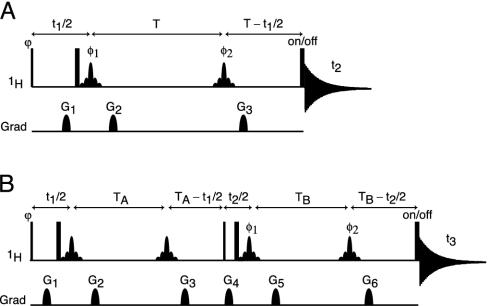Fig. 2.
Pulse schemes for homonuclear decoupled spectroscopy. (A) Basic pulse element for band-selective 1H homonuclear decoupling. (B) Selective constant-time COSY pulse scheme, in which band-selective decoupling is implemented to specifically detect internucleotide residual dipolar coupling. Narrow and wide pulses correspond to flip angles of 90° and 180°, respectively. Unless specified, pulses are applied along the x axis. Shaped 1H pulses are of the 180° REBURP type (39) (8-ms duration at 600 MHz, for a 500-Hz inversion bandwidth, centered at 5.8 ppm). Phase cycling: ϕ = x,–x; φ1 = 2(x),2(–x); φ2 = 4(x),4(–x); and receiver = y,–y,–y,y,–y,y,y,–y. (A) Quadrature detection in the indirect 1H dimension is achieved by applying an extra 1H 180° pulse just before the acquisition for half of the scans, storing signals separately, and using the usual “echo-antiecho” Fourier transform processing method (40, 41). All gradients are sine bell-shaped, with durations of 200 μs each, and (x,y,z) peak amplitudes in G/cm of (15,–33,20) for G1, (9,9,12) for G2, and (24,–24,32) for G3.(B) Quadrature detection in F1 is achieved by incrementing ϕ in the usual States-TPPI manner, and in F2 by insertion on alternate scans of the extra 1H 180° pulse just before acquisition (as in A). All gradients are sine bell-shaped, with durations of 200 μs, and (x,y,z) peak amplitudes in G/cm of (7,7,24) for G1, (5,5,–7) for G2, (12,12,17) for G3, (15,–33,20) for G4, (9,9,12) for G5, and (24,–24,32) for G6.

